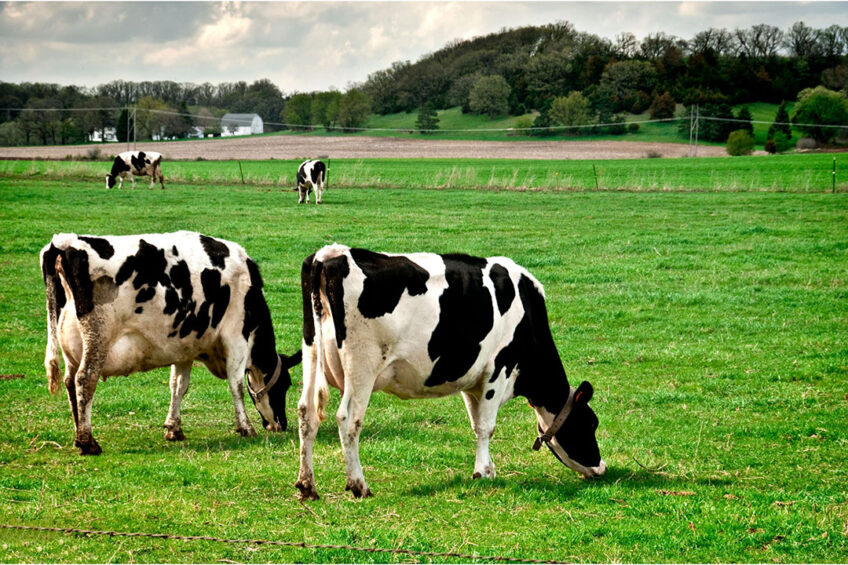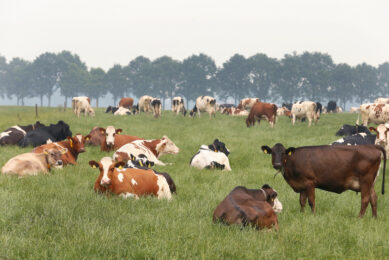Dairy producers’ interest in regenerative farming grows

Interest among dairy producers in regenerative farming practices continues to grow with more than 3,000 people flocking to 2 events organised by the Royal Association of British Dairy Farmers (RABDF) in recent weeks.
The southern Royal Association of British Dairy Farmers showcase event took place in the South West. Dairy farmer Neil Baker, who runs 1,800 predominantly Holstein herd on a high-yielding indoor system at Haselbury Plucknett, Somerset, is one of Arla’s regenerative pilot farms.
Baker’s cows are milked 3 times a day, producing 55,000 litres of milk on his 3,200 acres of owned, rented and contract-farmed land.
Regenerative farming
As one of the pilot regenerative farmers, Baker says the concept encompasses much more than simply focussing on the soil, preferring to use the term ‘circular farming’.
As part of the pilot project, he is looking to grow maize without any chemical inputs and understand the economic side by calculating carbon emissions from ‘ghost acres’.
He uses digestate from an AD plant on his farm on the crops he grows, which includes wheat, barley, peas and grass, and has established important pollinator corridors, which provide a barrier for wildlife.
‘Carbon tunnel vision’
Visitors to the event heard Tedx talk speaker Ffinlo Costain explain how cows are part of the climate solution, with methane not the primary cause of global warming. He outlined how the UK is already below the net zero global warming point when it comes to the gas.
“Cows are an easy distraction from fossil fuels. Carbon tunnel vision means people are fixated on greenhouse gas emissions, when climate change isn’t just about greenhouse gases; it’s also driven by biodiversity loss and desertification,” said Costain.
He added: “When cows are grazed correctly – by tall sward grazing, for example – they can deliver a cooling effect on the earth and are central to the climate solution. Cows in a regenerative farm system help the soil to sequester carbon; they restore ecological connectivity, helping us to solve the climate crisis while also producing fantastic nutrient-dense food, supporting livelihoods, and feeding communities all around the world.”
Cows seek fields that have not been sprayed
The RABDF northern farm event took place in early July at Mark and Jenny Lee’s Park House Farm, Torpenhow, where the couple showcased their organic unit. Their farm consists of 175 milking crossbred cows, certified 100% Pasture for Life and mob-grazed on a 30-40 day rotation using 2.5km of grazing tracks.
“Dairy done well and regeneratively supports carbon sequestration…”
Half of their milk goes into the farm’s cheese-making business and the rest is sold to First Milk. They are also pioneering selling liquid milk directly to local cafes and farm shops using an innovative plastic-saving system, Freshkeg.
Their move to regenerative farming came when their cows actively sought out an area of a field to graze that had not been sprayed, which led them to go down the organic route. They now have an area of silvopasture for grazing and have incorporated 80 pigs into the rotation. Before bird flu restrictions they also reared 1,800-2,000 free-range broiler chickens a year, which helped improve the pasture through their organic muck.
No single template of regenerative farming
Northern keynote speaker Rob Percival, head of policy at the Soil Association, said there were no one way of doing regenerative farming: “It’s adaptive, responsive, context matter and there’s no one template that fits all. It’s the outcomes that really matter.
“It’s a process of experimentation within the water cycles, nutrient cycles, natural pollination, and so on, producing food within the natural landscape while building natural capital,” he said.
Among the companies attending were First Milk’s Sustainability director, Mark Brooking, who said the Lees’ story was moving having come through adversity at a time of low milk prices by stepping away from the conventional treadmill and turning to regen practices.
“Dairy done well and regeneratively supports carbon sequestration, biodiversity, water resilience, the list goes on – and is very much part of the climate solution,” he added.
Join 13,000+ subscribers
Subscribe to our newsletter to stay updated about all the need-to-know content in the dairy sector, two times a week.










